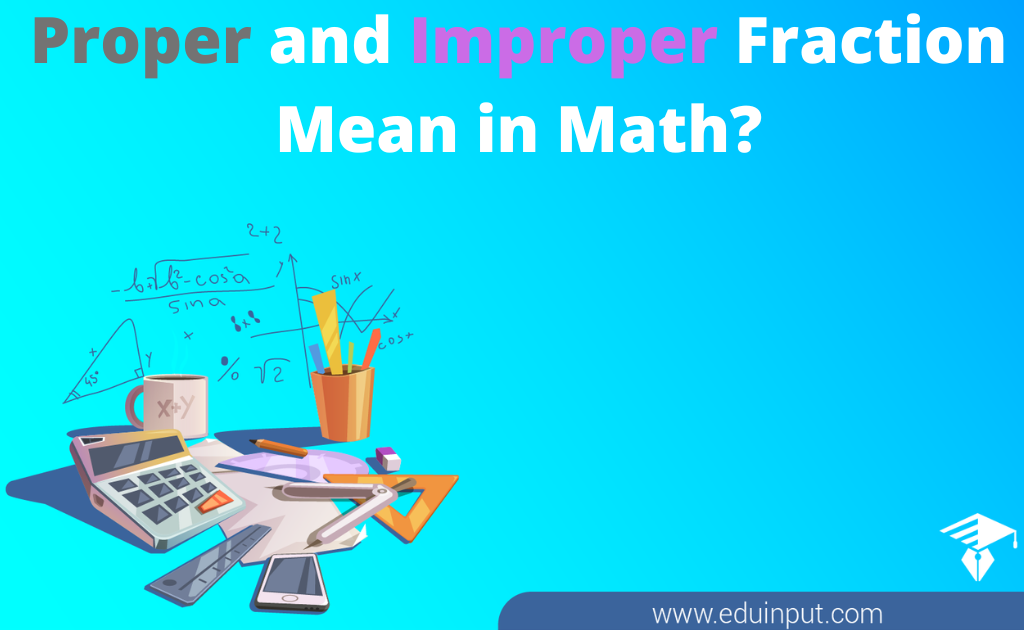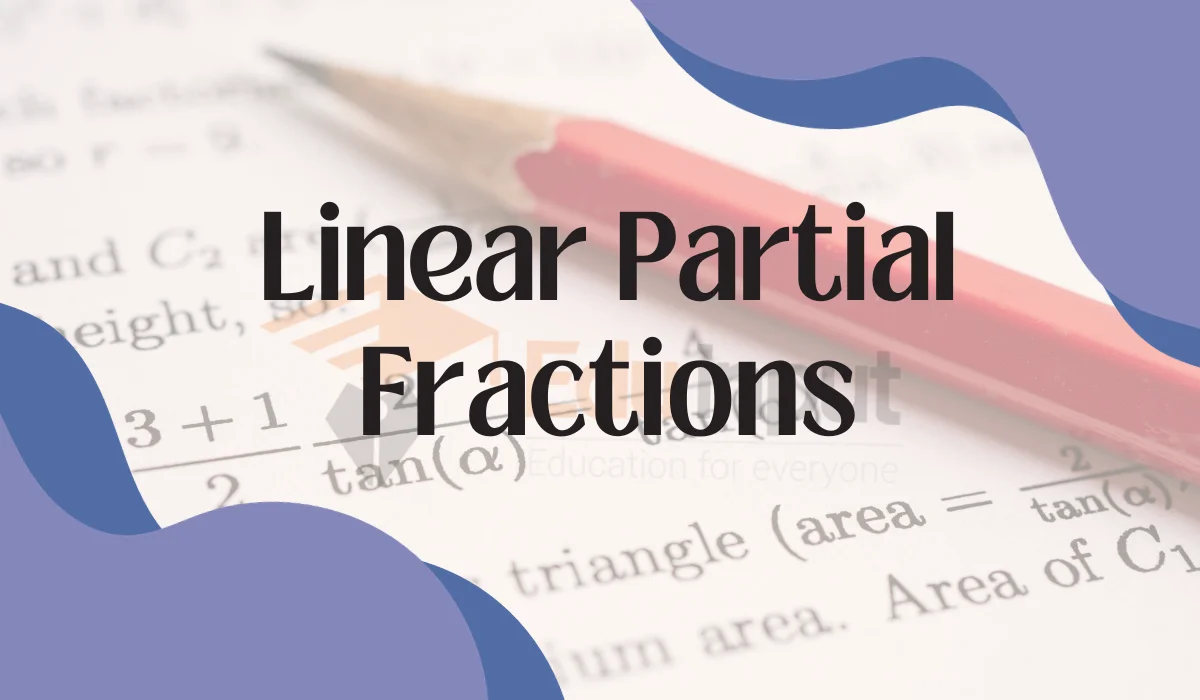The Four Cases of Partial Fractions Resolution
To express a single rational fraction as a sum of two or more two rational fractions is called a partial fraction. There are Four Cases of Partial Fractions Resolution
Resolution of p(x)/Q(X) into partial fractions when Q(X) has only non–repeated linear factors.
The polynomial Q(x) may be written as:
Q(x) =(x-a1)(x-a2)(x-a3)………..(x-an)
Where,
a1≠a2≠a3≠⋯.an
∴P(x)/Q(X) =A1/(x-a1)+A2/(x-a2)+…+An/(x-an) is an identity.
Where, the coefficient A1,A2,A3,….An are numbers to be found .
The method is explained by the following
Example:
Resolve, 7x+25/(x+3)(x+4) into partial fractions.
Solution:
Suppose
7x+25/(x+3)(x+4) = A/(x+3)+B/(x+4)……(1)
Multiplying both sides by (x+3)(x+4) equation(1) we get,
7x+25 =A(x+4)+B(x+3)…..(2)
As two sides identity are equal for all values of x,
Let us put x+3=0 ,
X=-3 in equation (2)
7(-3)+25=A(-3+4)+B(-3+3)
-21+25=A(1)+B(0)
4=A+0
4=A
Putting x+4=0 ,x=-4 in equation(2)
7(-4)+25=A(-4+4)+B(-4+3)
-28+25=A(0)+B(-1)
-3=0-B
-3=-B
3=B
Put the value of constant A and B in equation (1)
7x+25/(x+3)(x+4)=4/(x+3)+3/(x+4)
When Q(x) has repeated linear factors:
P(x)/Q(X)=A1/(x-a1)1+A2/(x-a2)2+ ….+An/(x-an)n
if the polynomial has a factor (x-a)n, n≥2, and n is a positive integer, then P(X)/Q(X) may be written as the following identity :
Where the coefficients A1, A2, A3,….An are numbers to be found. The method is explained by the following
Example:
Resolve, x2+x-1/(x+2)3 into partial fractions.
Solution:
Suppose
x2+x-1/(x+2)3 =A/(x+2)+B/(x+2)2+c/(x+2)3……(1)
Multiplying both side by(x+2)3 equation (1)
X2+x-1=A(x+2)2 +B(x+2)+C…….(2)
Put x+2=0,
X=-2 in equation in (2)
(-2)2-2-1=A(-2+2)2+B(-2+2)+C
4-2-1=A(0)+B(0)+C
1=0+0+C
1=C
From equation (2)
X2+x-1=A(x2+4x+4)+B(x+2)+C……(3)
Equating the coefficient of x2 and x in (3) we get,
1=A…….(a)
1=4A+B……(b)
Put the value of (A) in equation b
1=4(1)+B
1=4+B
1-4=B
-3=B
Put the value A,B and C in equation (1)
x2+x-1/(x+2)3=1/(x+2)-3/(x+2)2+1/(x+2)3
When Q(x) contains a non-repeated irreducible quadratic factor.
A quadratic factor is irreducible if it cannot be written as the product of two linear factors with real coefficients. For example, x2+x+1 and x2+3 are irreducible quadratic factors.
If the polynomial Q(x) contains a non-repeated irreducible quadratic factor then P(x)/Q(x) may be written as the identity having partial fractions of the form Ax + B/ax2+bx+c where A and B are the numbers to be found. the method is explained by the following
Example:
Resolve 3x-11/(x2+1)(x+3) into partial fractions.
Solution:
Suppose:
3x-11/(x2+1)(x+3)=Ax+B/x2+1 +C/(x+3) …..(1)
Multiplying both side (x2+1)(x+3) by equation(1),we get
3x-11= (Ax +B) (x+3) +C(x2+1)………(2)
Put x+3=0
X=-3
In equation (2)
3(-3)-11 = (Ax+B)(-3+3)+C((-3)2+1)
-9-11=(Ax+B)(0)+C(9+1)
-20=10C
C=-20/10
C=-2
From equation (2)
3x-11=Ax2+3Ax+Bx+3B+Cx2+C……..(3)
Comparing the coefficient of x2 and x in equation ( 3)
A+C=0…..(a)
3A+B=3……(b)
Put the value C =-2 in equation (a)
A-2=0
A=2
Put the value A=2 in equation (b)
3(2)+B=3
6+B=3
B=3-6
B=-3
Put the value A,B,C in equation (1)
3x-11/(x2+1)(x+3)=2x-3/x2+1 -2/x+3
When Q(x) has repeated irreducible quadratic factors:
if the polynomial Q(x) contains a repeated irreducible quadratic factor.
(ax2+bx+C)n, n≥2 and n is a positive integer, than P(x)/Q(x) may be written as the following identity:
P(x)/Q(x)=A1x+B1/(ax2+bx+c)+A2x+B2/(ax2+bx+c)2+……+Anx+Bn/(ax2+bx+c)n
Where A1,B1,A2,B2,………,An,Bn are numbers to be found .the method is explained through the following
Example:
Resolve 4x2/(x2+1)2(x-1) into partial fractions:
Solution:
Suppose
4x2/(x2+1)2(x-1)=Ax+B/(x2+1)+Cx+D/(x2+1)2+E/(x-1)…(1)
Multiplying both side(x2+1)2(x-1) by equation (1) we get,
4×2=(Ax+B)(x2+1)(x-1)+(Cx+D)(x-1)+E(x2+1)2…..(2)
4x2=(A+E)x4+(-A+B)x3+(A-B+C+2E)x2+(-A+B-C+D)x+(-B-D+E)………….(3)
Putting x-1=0
x=1 in (2) we get
4=E(1+1)2
4=E(2)2
4=4E
E=4/4
E=1
Equating the coefficient of x4,x3,x2,x,in (3) we get
0=A+E….(a)
0=-A+B….(b)
4=A-B+C+2E…..(c)
D=A-B+C……..(d)
Put the value of E=1 in equation (a)
0=A+1
A=-1
Put the value of A =-1 in equation (b)
O=-(-1)+B
B=-1
Put the value of A,B,E in equation (c)
4=-1-(-1)+C+2(1)
4=-1+1+C+2
C=2
Put the value A,B,C in equation (d)
D=-1+1+2
D=2
Put the value A,B,C,D,E
4x2/(x2+1)2(x-1)=-x-1/(x2+1)+2x+2/(x2+1)2+1/(x-1)
Frequently Asked Question-FAQs
What is partial fraction math?
Partial fractions are the fractions that are used in the decomposition of a rational expression. So, when an algebraic expression is split into a sum of two or more rational expressions, each part is referred to as a partial fraction.

 written by
written by 





Leave a Reply